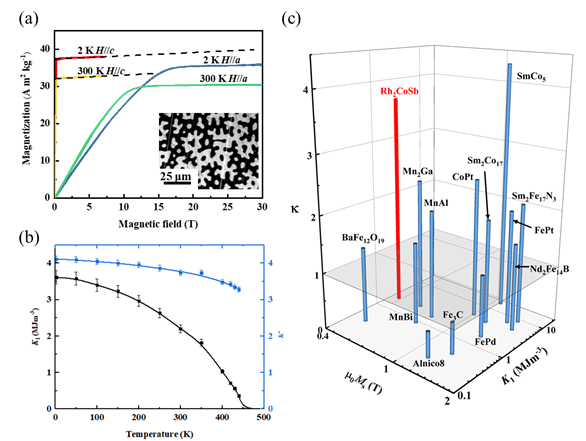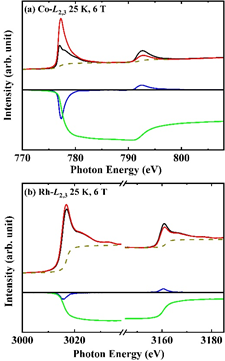Cerdanyola del Vallès, 4th December 2020. Digital information is steadily increasing year by year. To satisfy this huge demand, storage capacities of hard disk drives have continuously evolved over the last decades and the search for strong magnetic materials attracts world-wide interest as they have a crucial impact on energy, transport and information storage/conversion application.
An ideal material for recording should be magnetically hard for storage and soft for writing. HAMR (heat-assisted magnetic recording) technology enables increasing the amount of data that can be stored on a magnetic device. It records information at a high temperature heating from a laser beam confined well below the diffraction limit, <50-nm wide, to write to media near 450°C with high magnetic anisotropy that would normally be unwritable under available magnetic fields. This high anisotropy guarantees thermal stability even for grain sizes around 5-nm diameter, which are necessary for major increases in storage density.
Therefore, there is a great interest in developing alternative strong magnets with a strong magnetocrystalline anisotropy, a fairly suitable Tc and good thermal conductivity for development as new thin film media.
An international collaboration led by teams from the Max Planck Institute (Germany) and including experiments at the Trinity College Dublin (Ireland), the ALBA Synchrotron (Spain), the Dresden High Magnetic Field Laboratory (Germany), IFW and TU Dresden (Germany) have found on Rh-based magnetic Heusler compounds a good partner.
Rh2CoSb is introduced as a new hard magnet with potential for thin film magnetic recording. A magnetocrystalline anisotropy of 3.6 MJm-3 is combined with a saturation magnetization of μ0Ms = 0.52 T at 2 K (2.2 MJm-3 and 0.44 T at room-temperature). The magnetic hardness parameter κ of 3.7 at room temperature is the highest observed for any rare-earth free hard magnet.

Fig.1. (a) Magnetization curves at 2 K and 300 K with the field along the a or c axes. The insert shows a pattern of branched domains at the surface perpendicular to the c axis, typical of a strong uniaxial ferromagnet. (b) Magnetocrystalline anisotropy calculated from magnetization curves at different temperatures. The blue line shows the magnetic hardness parameter κ at different temperatures. (c) Comparison of the magnetic hardness parameter κ with other hard magnets. The light grey plane marks the threshold κ = 1.
Apart from conventional laboratory techniques, synchrotron light, in particular X-ray Magnetic Circular (XMCD) at ALBA has been used to characterize the magnetic properties. The XMCD experiments at BOREAS beamline were key to directly probe the origin of such giant magneto-crystalline anisotropy that supports this material for magnetic recording.
The anisotropy is related to an unquenched orbital moment of 0.42 µB on Co, which is hybridized with neighboring Rh atoms with a large spin-orbit interaction. The spin and orbital moments of Rh obtained from the sum rule analysis are 0.28 µB and 0.020 µB, respectively. Using these moments, together with those of Co, the total magnetic moment of Rh2CoSb is in good agreement with the magnetic measurement of 2.6 µB.
 |
Fig. 2. XAS and XMCD spectra of Rh2CoSb. a) Co L2,3 and b) Rh L2,3. Spectra were taken at 25 K temperature and 6 T induction field. The photon helicity is oriented parallel (µ+) in black solid line or antiparallel (µ−) in red solid line to the magnetic field. The background is shown in the black dash line with edge jumps. |
Moreover, the c-axis thermal conductivity of 20 Wm-1K-1 at room temperature is roughly twice that of unsegregated L10 FePt (11-13 Wm-1K-1), or A1 FePt (9 Wm-1K-1), which are the current HAMR materials. The anisotropic transport properties, including magnetoresistance, anomalous Hall effect, and Seebeck effect, result from the anisotropic electronic structure, that leads to an anisotropic mobility of the charge carriers. The pronounced temperature-dependence of the anisotropy that follows from its Tc of 450 K, together with a high and anisotropic thermal conductivity of 20 Wm-1K-1, makes Rh2CoSb a candidate for development for heat assisted writing with a recording density in excess of 10 Tb/in.-2

Fig.3. Transport properties of Rh2CoSb . (a) Longitudinal resistivity along the c (red curve) and the a axis (blue curve). (b )and (c) Thermal conductivity along the c and a axes and the charge carrier contribution (estimated from the Wiedemann–Franz law. The remaining part is mainly the phonon contribution.
"All the features found in this study commend Rh2CoSb as a candidate for HAMR media with a recording density of more than 10 Tb//in.-2 and high writing speed", the scientists of the study concluded.




